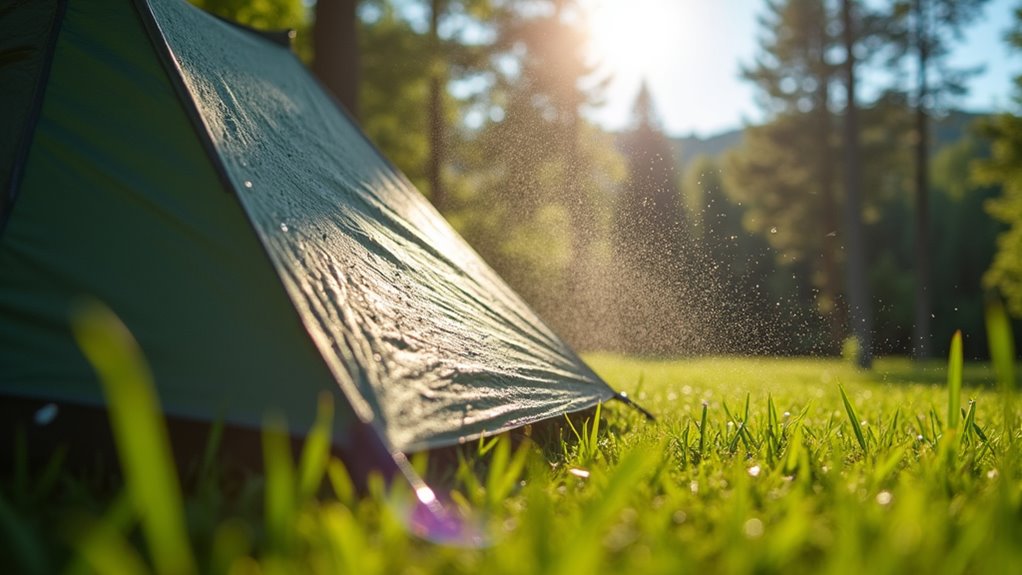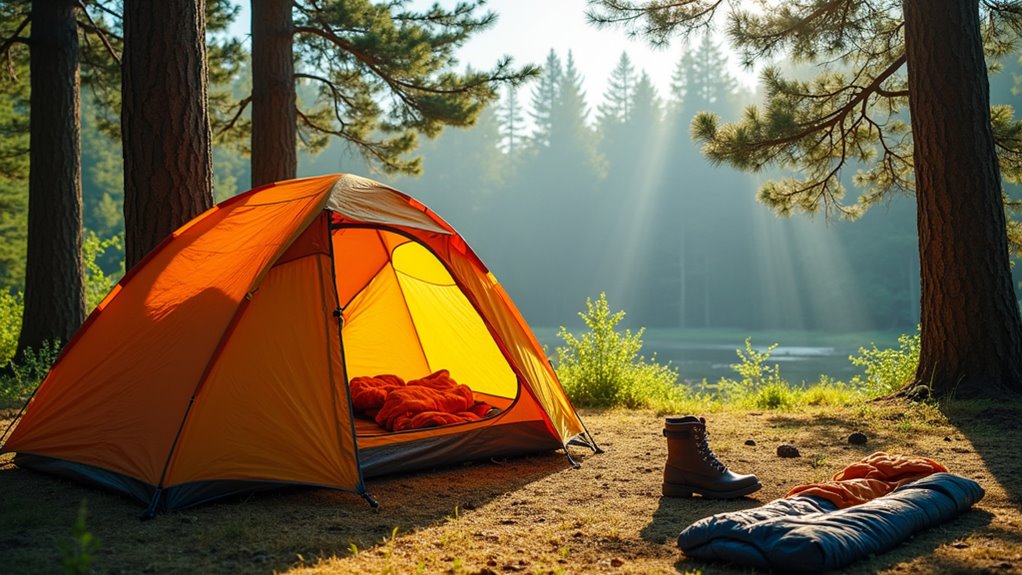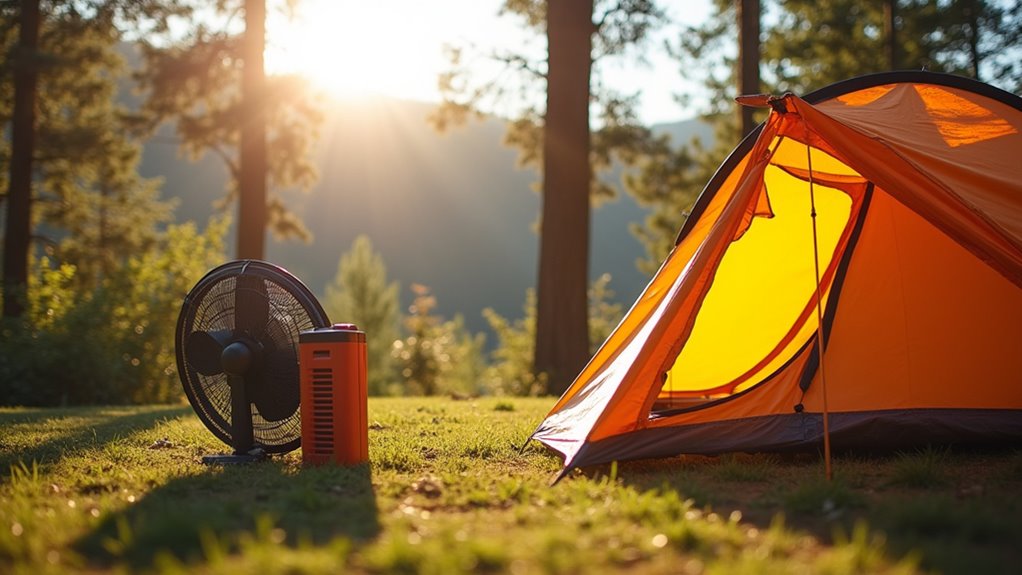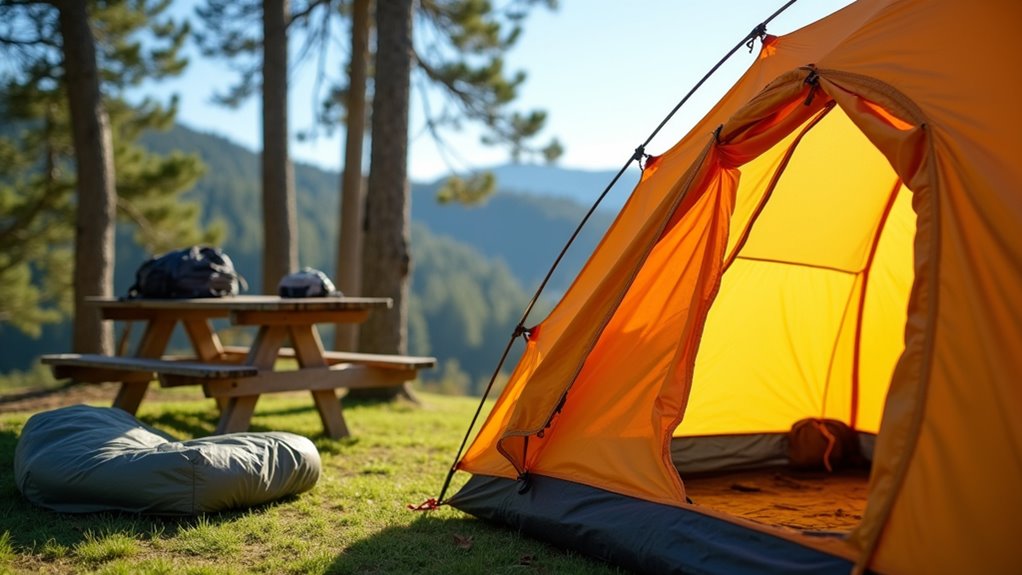How To Dry A Tent
This post contains affiliate links. As an Amazon Associate, we earn from qualifying purchases.
To dry your tent effectively, remove excess moisture using large mops or towels and wipe surfaces with microfiber cloths. Maintain a drying environment with humidity between 45% and 65% and temperatures from 60°F to 70°F, ensuring good ventilation through fans and open vents. Use drying racks to improve airflow and regularly inspect the fabric for damage. Following these steps helps prolong your tent’s lifespan and ensures thorough drying. Further details and additional tips will be provided later in the article for those interested in learning more.
Essential Facts in 30 Seconds
- Use large mops or towels to remove excess water from the tent.
- Keep humidity between 45% and 65% with good ventilation.
- Hang the tent upside down for better air circulation.
- Use dehumidifiers and fans to speed up drying.
- Store the tent in a cool, dry place to prevent mold.
Initial Moisture Removal Techniques

Drying your tent well stops mold and mildew from growing. Use big mops or towels first. They soak up water from the tent’s surface fast.
Wipe the inside walls with microfiber cloths next. These cloths catch small drops of condensation. Regular cleaning helps maintain tent longevity and prevents moisture buildup.
Separate the rainfly from the tent’s inner part. This lets you dry wet areas better and lowers humidity. Shake out water from seams, corners, and folds. Water trapped there keeps the tent damp.
Never pack your tent when it’s still wet. Make sure most water is gone before packing.
Set up your tent on dry, high ground. This stops water from soaking up from the soil. Point the tent door toward the wind. Good airflow dries the tent quicker. Additionally, always ensure the tent is completely dry before storage to prevent mildew.
These steps help your tent stay dry and last longer.
Drying Environment Optimization
Control humidity, ventilation, and temperature to improve your drying environment.
Keep humidity steady between 45% and 65%. Use hygrometers or smart sensors to check humidity often. Connect dehumidifiers with controllers to adjust humidity automatically. Maintaining proper humidity levels is crucial to prevent mold growth on the tent.
Ensure good ventilation and air flow. Place an exhaust fan at the top of your tent to push out moist air. Put intake fans near the bottom to bring fresh air inside. Keep the tent under negative pressure to remove moisture well. Proper air circulation is essential for effective drying and to avoid damp spots.
Keep the temperature between 60°F and 70°F. This range helps keep the product strong and tasty. Avoid big changes in temperature to stop mold and flavor loss. Use smart sensors to watch temperature and make quick changes. Additionally, ensure the area is free from debris that could soil the tent during the drying process.
These tips create the best drying setup.
Tent Setup for Drying

Set up your tent carefully for drying to get the best results.
Remove extra equipment such as lights and fans to make space. Clean the tent inside to remove dirt and germs. Check the tent fabric for holes to keep it sealed.
Place drying nets or racks evenly in the tent. Hang buds upside down using clothespins and keep space between them. This stops mold and helps buds dry evenly.
Use exhaust fans to keep air moving, but don’t blow air directly on the plants. Use thermometers and hygrometers to watch temperature and humidity. Keep these at the right levels for drying plants well.
This setup helps your harvest dry safely and quickly.
Climate and Seasonal Considerations
Drying a tent in cold places requires attention to temperature and humidity.
Cold air slows drying a lot. Keep the temperature above 60°F (15°C) using a heater.
Humid air holds water and makes drying take longer. Use fans and dehumidifiers to move air and remove moisture.
These steps help your tent dry faster and stay fresh.
Cold Climate Drying
Drying a tent in cold places is hard. Cold air and little sun slow drying a lot. Follow these tips to keep your tent good for years:
| Method | How it helps |
|---|---|
| Pick a sunny spot | South-facing areas get more sun and less wind. |
| Use microfiber towels | Wipe water off to dry faster. |
| Open all vents | Air flows better and dries the tent quicker. |
| Dry indoors | Use warm rooms or places with dry air machines. |
| Raise the tent | Keep it off ice and snow to avoid wetness again. |
Sunlight can dry things up to 5 times faster. Air moving inside the tent speeds water drying too. Use towels to soak water; this can cut drying time by half. Drying inside saves your tent from cold winds and frost. Keeping your tent clean and dry will help prevent mold and bad smells. This way, it lasts long and stays strong. Additionally, maintaining proper ventilation strategies is essential to minimize moisture buildup while drying.
Humidity Impact on Drying
Humidity affects how fast your tent dries. High humidity, common in warm or tropical areas, slows drying. Use fans to move air every few minutes. This helps air flow and dries the tent faster.
Dry places with low humidity dry tents quickly. Put your tent in the sun and open windows to let air flow. Cold weather can slow drying too. Watch the temperature and change your drying plan as needed.
Use moisture absorbers like silica gel when humidity is high. A well-ventilated tent helps in reducing moisture buildup and accelerates the drying process. Changing your steps based on humidity helps stop moisture from staying in your tent. This keeps your tent fresh and ready to use.
Equipment and Tools for Speeding Up Drying

Speed up tent drying with airflow tools, dampness absorbers, and drying racks.
Oscillating fans move air well. Dehumidifiers lower room moisture, which can help prevent mold growth in your tent.
Strong drying racks or portable nets save space and boost airflow.
These tools help your tent dry fast and fully. Quick drying prevents mold and keeps fabric strong. Additionally, ensure your tent is completely dry before storing it to avoid mold growth and maintain its integrity.
Use them for better camping gear care.
Airflow Enhancement Tools
Speeding up tent drying requires good airflow tools. Inline booster fans push air through ducts, making weak air stronger.
Oscillating and clip-on fans move air around evenly. This stops humid spots from forming inside the tent. Fans lower humidity on wet surfaces, helping water evaporate faster.
Use smooth ducts with gentle bends to let air flow freely. Pair exhaust inline fans with simple intake ducts for fresh air swap.
Drying tent kits often include fans and speed controls for balanced airflow. Place these tools well to dry tents quickly and stop mold growth.
Moisture Absorption Materials
Effective moisture absorption materials help dry your tent faster. Silica gel packs and activated charcoal bricks reduce humidity inside your tent.
Place dehumidifier bags in corners or near wet gear for best results. Microfiber cloths and towels like PackTowl work well to wipe damp surfaces.
Use moisture-absorbing floor mats to keep ground dampness from rising. Portable chemical dehumidifiers keep humidity low in closed spaces.
Always dry these materials well after use to stop mildew and keep them working. Keeping your tent dry improves comfort and prevents mold growth.
Efficient Drying Racks
Efficient drying racks help dry your tent faster after rain. Using the right materials makes a big difference. Here are some common drying rack types and their benefits:
| Rack Type | Benefits |
|---|---|
| Circular Aluminum | Lightweight and stable. No sharp rods to damage fabric. |
| Mesh Netting | Good air flow for even drying. |
| Hanging Frames | Air flows freely. Great for homemade setups. |
| Rolling Racks | Easy to expand for bigger drying needs. |
Air moves best around your tent when racks allow space and airflow. Clips hold the fabric tight without tearing it. This helps your tent dry faster and stay safe. Choose racks that fit your space and drying needs well.
Post-Drying Storage and Maintenance

Keep your tent dry before storing it. Damp tents cause mold and bad smells.
Store your tent in a cool, dry, dark place. Avoid attics and garages that get too hot or humid. Use big mesh bags. They let air flow and stop moisture. Don’t pack the tent tightly in its small stuff sack for long-term storage. Tight packing traps humidity and damages the fabric.
Check zippers, seams, and poles for damage. Clean the tent with a soft cloth and mild fabric cleaner. This keeps the waterproof layer strong. Regularly inspect signs of wear to ensure your tent remains in good condition.
After cleaning, apply a waterproof spray to refresh the fabric’s protection. Remove leaves, dirt, and bugs from your tent. These can cause damage and attract pests.
Follow these steps to keep your tent safe and ready for your next trip. Your tent can last for many years with good care.
Frequently Asked Questions
Can I Dry My Tent in a Tumble Dryer?
Drying your tent in a tumble dryer is unsafe. The heat can damage the fabric and poles. It may also cause a fire risk. Air drying works best. Hang your tent in a shaded spot away from direct sun. Use fans to help dry it faster. This way, your tent stays safe and lasts longer. Always dry your tent completely before storing to avoid mold and bad smells.
How Long Does It Typically Take to Dry a Tent?
Drying a tent usually takes between 30 minutes and 1.5 hours. Weather plays a big role. Sunny, breezy days dry tents much faster. Shade and high humidity slow the process down. Open all tent flaps and windows to let air flow inside. Hanging the tent in direct sunlight helps water evaporate quickly. Using a clean towel to blot wet spots speeds drying too. Dry tents prevent mold and keep gear fresh. Always dry your tent soon after use for best results.
Is It Safe to Use a Hair Dryer on My Tent?
Using a hair dryer on your tent can help dry it quickly. Keep the dryer on low heat to avoid damage. Hold the dryer a few inches away from the fabric. High heat can melt or weaken the tent material. Always move the dryer around to prevent hot spots. This simple care helps your tent last longer. Drying your tent fast stops mold and bad smells. Stay safe and protect your gear with these easy steps.
What Should I Do if My Tent Smells Musty After Drying?
A musty smell in your tent after drying means moisture stayed inside. Wash the tent using special cleaners made for outdoor gear. Treat any dirty spots with a gentle scrub. Let the tent dry completely in fresh air, not in direct sunlight. Keep your tent clean and dry after each trip. This stops mold and bad odors from forming. Proper care helps your tent last longer and smell fresh on every adventure.
Can I Dry My Tent in a Garage With No Windows?
Drying a tent in a garage without windows works well with the right tools. Place fans around the tent to move air and help it dry faster. A dehumidifier removes moisture from the air, cutting down drying time and stopping mold growth. Keep the garage door open slightly for better air flow if possible. Check the tent often to avoid damp spots. This method keeps your tent safe and ready for your next trip.
Conclusion
Dry your tent step by step for the best results. First, shake off all water and damp areas. Find a sunny, breezy spot to set up your tent. Spread it wide to let air reach every corner. Use a small fan or clean towels to help dry faster. Check the weather—dry days work best. Store your tent in a dry place once it feels dry. This keeps it safe from mold and damage. Follow these simple steps to keep your tent ready for your next trip. A dry tent lasts longer and stays strong.
